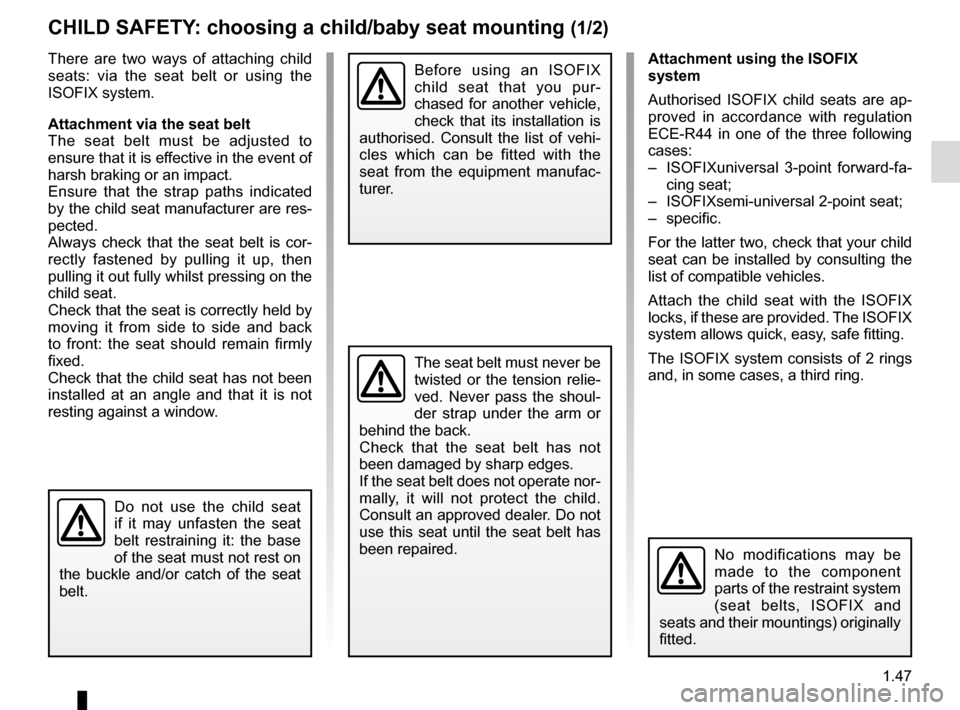Page 8 of 292

1.2
KEY, RADIO FREQUENCY REMOTE CONTROLS: general information (1/2)
Radio frequency remote
control A or B
1 Ignition-starter key, door key.
2 Locking the doors and tailgate.
3 Unlocking the doors and tailgate.
3 Unlocks all doors and boot or, de-
pending on the vehicle, the driver’s
door only. Refer to the information on
“Key, radio frequency remote con-
trol: use” in Section 1.
AB
4 Locks/unlocks the boot and, depend-ing on the vehicle, the side sliding
door.
23
1
4
2
3
1
The key must not be used for any
function other than those described
in the handbook (removing the cap
from a bottle, etc.).
Advice
Avoid leaving the remote control in
hot, cold or humid areas.
Driver’s responsibility
Never leave your vehicle
with the keys inside when
leaving a child (or animal)
in the car, even for a short period.
The reason for this is that the child
may endanger himself or others by
starting the engine, activating equip-
ment such as the window winders
for example, or locking the doors.
Risk of serious injury.
Page 10 of 292

1.4
KEYS/RADIO FREQUENCY REMOTE CONTROL: use (1/2)
Unlocking the doors and
tailgate
Pressing and holding button 2 unlocks
all the opening elements.
A short press on button 3 unlocks the
rear doors and, depending on the vehi-
cle, the sliding side doors.
The hazard warning lights and indica-
tor lights flash once to indicate that the
doors have unlocked.
2
1
Driver’s responsibility
Never leave your vehi-
cle with the key inside and
never leave a child (or a
pet) unsupervised, even for a short
while.
They may pose a risk to themselves
or to others by starting the engine,
activating equipment such as the
electric windows or by locking the
doors.
Risk of serious injury.
The key must not be used for any
function other than those described
in the handbook (removing the cap
from a bottle, etc.).
1
3
2
NB: If a door is not opened within ap-
proximately 2 seconds of the door
being unlocked by remote control, the
doors will lock again automatically.
NB: Depending on the vehicle, a single
press on button 2 unlocks the driver’s
door only. A second press unlocks all
the doors.
Page 53 of 292

1.47
CHILD SAFETY: choosing a child/baby seat mounting (1/2)
There are two ways of attaching child
seats: via the seat belt or using the
ISOFIX system.
Attachment via the seat belt
The seat belt must be adjusted to
ensure that it is effective in the event of
harsh braking or an impact.
Ensure that the strap paths indicated
by the child seat manufacturer are res-
pected.
Always check that the seat belt is cor-
rectly fastened by pulling it up, then
pulling it out fully whilst pressing on the
child seat.
Check that the seat is correctly held by
moving it from side to side and back
to front: the seat should remain firmly
fixed.
Check that the child seat has not been
installed at an angle and that it is not
resting against a window.
Do not use the child seat
if it may unfasten the seat
belt restraining it: the base
of the seat must not rest on
the buckle and/or catch of the seat
belt.
The seat belt must never be
twisted or the tension relie-
ved. Never pass the shoul-
der strap under the arm or
behind the back.
Check that the seat belt has not
been damaged by sharp edges.
If the seat belt does not operate nor-
mally, it will not protect the child.
Consult an approved dealer. Do not
use this seat until the seat belt has
been repaired.
No modifications may be
made to the component
parts of the restraint system
(seat belts, ISOFIX and
seats and their mountings) originally
fitted.
Attachment using the ISOFIX
system
Authorised ISOFIX child seats are ap-
proved in accordance with regulation
ECE-R44 in one of the three following
cases:
– ISOFIXuniversal 3-point forward-fa- cing seat;
– ISOFIXsemi-universal 2-point seat;
– specific.
For the latter two, check that your child
seat can be installed by consulting the
list of compatible vehicles.
Attach the child seat with the ISOFIX
locks, if these are provided. The ISOFIX
system allows quick, easy, safe fitting.
The ISOFIX system consists of 2 rings
and, in some cases, a third ring.Before using an ISOFIX
child seat that you pur-
chased for another vehicle,
check that its installation is
authorised. Consult the list of vehi-
cles which can be fitted with the
seat from the equipment manufac-
turer.